Museums and Exhibitions in New York City and Vicinity
| Home | | Museum Guide | | International | | Architecture andDesign | | Theater |
GLENN LONEY'S MUSEUM NOTES
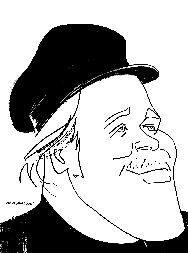 |
| Caricature of Glenn Loney by Sam Norkin. |
CONTENTS, November 2003
[01] "Winter King" in Amberg
[02] Farewell to Michael Mathias Prechtl
[03] "Theatrum Mundi" in Munich
[04] German Railway Museum in Nuremberg
[05] Franz West in Kunsthaus Bregenz
[06] Paris Lodron in Salzburg Cathedral Museum
[07] Berlin's Buddy Bears
[08] "Art in the DDR" in Berlin
[09] New I. M. Pei Austellungshalle in Berlin
[10] Kennedy, Pei, and"The Idea of
Europe"
[11] Frank Ghery's AXIA at the Brandenburg
Gate
[12] "Mittenmang" at Schwules Museum>
[13] "Communist Dream-Factory" in Frankfurt
[14] Maria Callas' Stage-Jewels in Verona
[15] The Venice Biennale
[16] "100 Years of Wiener Werkstätte" at MAK in Vienna
[17] Comix in Brussels
[18] The Great Falkirk Wheel
Copyright © 2003 Glenn Loney.
For editorial and commercial uses of the Glenn Loney INFOTOGRAPHY/ArtsArchive of international photo-images, contact THE EVERETT COLLECTION, 104 West 27th Street, NYC 10010. Phone: 212-255-8610/FAX: 212-255-8612.
For a collection of Glenn Loney's previous columns, click here.
Some New Exhibitions in "Old" Europe
Perhaps the most-discussed and greatly-hyped European art exhibition of
the past summer was the Venice Biennale—which was truly impressive. But there
were other interesting, if smaller-scaled, shows on view in various venues frequented
by tourists. Some unusually attractive installations were deliberately mounted
in out-of-the-way locales, obviously to stimulate tourism and, incidentally,
Local Pride.
Herewith some INFOTOGRAPHY ArtsArchive photos your traveling reporter took of various types of exhibitions. In some cases, however, press-photos have been provided, as credited. This is intended primarily as a visual-record, not as in-depth surveys of specific shows. There's neither World enough, nor Time, for that…
 |
| THE
WINTER KING--Satiric Snowman image of Frederic V—very briefly King
of Bohemia—by Michael Mathias Prechtl, who, like Frederic, was born
in Amberg, Bavaria. From: Glenn Loney Prechtl Poster Collection. |
Der Winterkönig/The Winter King
Stadtmuseum Amberg, Bavaria
[Closing November 2, 2003]
In the intriguing Amberg re-creation of the life and times of one of European history's briefest reigns, there is also a whiff of Bertolt Brecht's drama, Mother Courage. Brecht's indomitable anti-heroine loses all her children in the Thirty Years War. The "Winter King," however, lost the Throne of Bohemia, in Prague, only short months after he had been crowned.
The disastrously unfortunate Frederic V—or Friedrich—was the last Electoral Prince—or Kurfürst—of the Upper Palatinate—or Oberen Pfalz. He was born in Amberg—which became a Bavarian city soon after his deposition—but the main seat of the Princes Palatine was Heidelberg Castle.
As leader of the Protestant Union in the Holy Roman Empire—which was overwhelmingly Roman Catholic—he was offered the Bohemian crown. Kaiser Ferdinand, the Holy Roman Emperor—not holy, and certainly not Roman—joined with Duke Maximilian of Bavaria to suppress King Frederic and the Protestants. At the famous Battle of White Mountain, he lost his throne, but Bohemia lost much more: its relative independence and its religious freedoms.
Frederic and his consort, Queen Elizabeth Stuart von der Pfalz, lived out their lives—with many children—in sad exile in The Hague. Frederic is frozen in history as a rather pathetic figure. Fortunately for him, he was related to the Dutch Protestant House of Orange and so was given a castle for his large family and court-in-exile. Elizabeth was the daughter of England's Protestant King James I, and the royal couple's splendid wedding-celebrations in London included a special performance of Shakespeare andFletcher's Two Noble Kinsmen—stunningly produced this fall at New York's Public Theatre.
Amberg itself is a richly historic city—but not on the main tourist-trails—so this impressive exhibition not only brought the fate of the Winter King and the turmoils of the Thirty Years' War back to life, but it also introduced thousands of tourists to a charming corner of Upper Bavaria—not far from Nuremberg and Bayreuth.
This splendid show will live on, thanks to its handsomely illustrated catalogue—which also puts the Wars of Religion in political and social context—and a companion CD. This Winter King CD reprises both texts and artifacts on display in the medieval Stadtmuseum. As this exhibition was mounted by Amberg and the Haus der Bayerischen Geschichte, you can contact the latter for CD, catalogue, and more information about Bohemia's last king. Phone: 011-49-821-3295-123. E-Mail: pressestelle@hdbg.bayern.de or try www.winterkoenig.de or www.hdbg.de
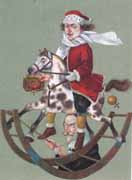 |
| PRECHTL'S
PUPPET-KING--Frederic, Elector of the Palatinate, shown as a pawn of forces
more powerful than he. From: Glenn Loney Prechtl Poster Collection. |
Fond Farewell To Michael Mathias Prechtl
Also born in Amberg was one of modern Germany's most prolific and ingenious artist-satirists, Michael Mathias Prechtl. This brilliant chronicler of European History, Art, and Literature passed away March 2003. Amberg's Stadtmuseum honored him with a retrospective of his work, a show for which, just before his death, he had created a special poster. In Bayreuth, a selective show of his famous posters was also on view during the summer.Although best-known in Central Europe—where his visual satires sometimes rubbed conservative authorities the wrong way—he had also provided illustrations for the Op-Ed page of the New York Times. His famous poster for Schirmer's Music features Beethoven with musicians nested in his voluminous hair.
Prechtl and his artist-wife, Frydl Zuleeg-Prechtl, were longtime friends of your reporter—who has one of the largest collections of Prechtl posters and lithographs in the United States. In fact, when I was writing for Opera News, he consented to create two special covers for the magazine: one for Richard Wagner, the other for Alban Berg. These are now Collectors' Items.
But my favorite Prechtl-Image is the photograph I took of him—a great bear of a man—standing in front of a very large View of Toledo. Not by El Greco—as those are in major museums—but by Prechtl, for Prechtl, as he never sold original drawings or paintings.
 |
| BAROQUE HORSE-LAUGH--In Wagnerian Bayreuth, near Frederic's Amberg, this wild stallion now stands in a glass garden-house. |
THEATRUM MUNDI:
All the World's a Stage—
Haus der Kunst, Munich
[Closing September 21, 2003]
Borrowing paintings, models, costumes, and other artifacts from many museum and private collections, this colorful exploration of the World of Baroque Theatre demonstrates how the stage mirrored the hierarchical nature of 17th and 18th century courts and societies. For those theatre-lovers and students who couldn't make it to Munich, there is a handsome and heavy catalogue which documents this show with both text and illustrations. Theatrum Mundi costs Euro 32. It can be ordered by contacting the museum. Phone: 011-49-89-211-27-0. E-mail: mail@hausderkunst.de or check out http://www.hausderkunst.de
Also available is the exhibition catalogue for GROTESK!—130 Years of Witty Art, which has been on view at the Haus der Kunst, concurrent with Theatrum Mundi. This very unsettling collection of paintings, illustrations, and objects has also been seen in Frankfurt's Schirn Kunsthalle and in other German venues. It seems a Natural for the Brooklyn Museum of Art. A number of noted artists are represented by unusual images which are certainly not representative of their major work. Tastelessness has not proved a bar to inclusion in this show. Martin Kippenberger's wood-sculpture shows a Frog nailed to the Cross. Its cryptic title: What's the difference between Casanova and Jesus? The facial-expression when nailed. This catalogue also costs Euro 32.
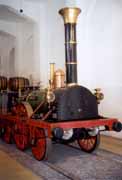 |
| GERMANY'S
FIRST STEAM-LOCOMOTIVE--The Adler is the prize of Nuremberg's Railway
Museum. Photo: ©Glenn Loney 2003. |
Deutsche Bundesbahn Museum—
Nürnberg/Nuremberg
[Permanent Installations] Just a few blocks from Nuremberg's immense and
newly renovated railroad station is the Railroad Museum of the German Federal
Rail-system. Among its vintage treasures is the Adler, Germany's first steam-locomotive.
A suite of elegant blue-and-gold carriages, outfitted especially for King Ludwig
II, are also preserved. He was the so-called "Dream-King" who built all those
castles in an age when fortified towers and keeps like those of Schloss Neu
Schwanstein were no longer needed.
The train-section of the museum also includes a 1930s sleek red Deco locomotive with very special markings: It features the Nazi Swastika on its prow. Amazing that such symbols were not long ago removed.
But the German Postal Museum—which shares the premises—offers even an more detailed documentation of the Nazi Past in
 |
| ROYAL
ORNAMENT--An elaborate neo-baroque decoration on the royal train of King
Ludwig II of Bavaria, on view in Nuremberg. Photo: ©Glenn Loney 2003. |
communications and transportation, complete with photos, posters, and film-clips.
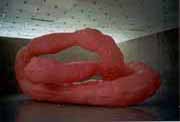 |
| FRANZ
WEST SHOWS SCULPTURE--Major piece in Kunsthaus Bregenz exhibition. Photo: ©Glenn Loney 2003. |
Franz West—Kunsthaus Bregenz
[Closing September 14, 2003]
The impressive Post-Post-Modernist glasshouse art-gallery in Festival City Bregenz each summer season showcases an outstanding artist of international renown. When it gave Jeff Koons the run of its four floors recently, I felt I was looking at things I already knew all too well. Indeed, I was surprised that anyone was still taking Koons seriously as an artist. But with Franz West's We'll Not Carry Coals this July, I was all at sea. I did not know what to make of West's bizarre prosthetic devices which he calls Passstücke or Fitted Pieces.
Fortunately, the press-release explained that West is a close reader of the works of Sigmund Freud, a fellow-Viennese. The strange appendages—which can be strapped onto the body—are designed to "give neuroses a physical form." From these, he has moved on to "furniture for sitting and reclining," made of industrial discards and pre-fabbed elements. These he covers with rugs or fabric. A set of these chair-sculptures were created for the DIA Art Foundation in New York. Commentators have called groups of these "communications installations."
The main gallery is occupied by several very large and boldly colored sculptures which look like nothing so much as huge constipated stools. But that may be reading too much into them. West is also very Big with painting over newspapers. As this virtual retrospective shows, he has tried most everything but imitating Rembrandt.
But how could I have missed his work all these years? He has shown at major galleries in New York and around the US, as well as in Europe, for over three
 |
| HAVE
A SEAT!--Chairs like tree-stumps: Franz West installation in Kunsthaus
Bregenz, Austria. Photo: ©Glenn Loney 2003. |
decades. And he has been included with single works in some of the most important modern exhibitions, including various Documentas in Kassel. Each year he has important shows in Europe, as well as his recent appearance in New York at the Gagosian Gallery. Studying the many show-credits in his bio, I realized I must have seen his work in some of these exhibitions, but it apparently did not make much of an impression. In fact, it still suggests hommages to other more original modern artists.
PARIS LODRON:
Statesman Between War andPeace—
Salzburg Cathedral Museum
[Closing October 26, 2003]
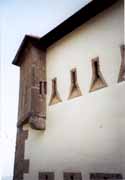 |
| MEDIEVAL
FORTRESS IN BAROQUE SALZBURG--Erected by Prince-Archbishop Paris Lodron
to protect his beautiful city from horrors of Thirty Years War. Photo: ©Glenn Loney 2003. |
There is a resonant link between this thoughtful glimpse of the powers of an absolutist Roman Catholic Potentate and the Protestant Winter King on exhibition in Amberg. Kurfürst Frederic lost almost everything—including his reputation—in the Thirty Years' War. In contrast, Prince-Archbishop Paris Lodron, of the City and Land of Salzburg—in deftly maneuvering to keep his people and lands out of the Wars of Religion—not only prevented any battles on Salzburg soil, but also launched a new era of prosperity and achievements in the arts.
The fortifications which Paris Lodron had constructed around Salzburg—still firm and impressive to this day—never had to be used, thanks to his diplomacy and political strategies. But he was also a Builder and not only of forts and castles. The great baroque Cathedral of Salzburg, as well as various churches, monasteries, and palaces were among his architectural achievements. He also founded the University of Salzburg, which opened in 1623.
In fact, in addition to the paintings, sculptures, religious objects, and other treasures on display in the Cathedral's museum, the whole of Baroque Salzburg is a kind of museum of Paris Lodron's great works. Near the close of his reign as both the temporal Prince and the absolute religious authority, he was named by the Salzburg Volk as "Father of the Fatherland." This sounds better in German…
Paris Lodron was not the only art-loving archbishop to enrich Salzburg with magnificent buildings and collections, however. The names of Markus Sittikus and Wolf Dietrich—and their architectural additions to the City of Salzburg—also still resonante above the River Salzach!
For more information: E-Mail: dommuseum.salzburg@kirchen.net or http://www.kirchen.net/dommuseum
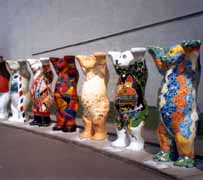 |
| BERLIN'S
BUDDY BEARS--Segment of great circle of Bears painted by artists of many
nations to promote International Understanding. Photo: ©Glenn Loney 2003. |
Berlin's United Buddy Bears:
Die Kunst der Toleranz/The Art of Tolerance
[On site of future US Embassy]
Fake Cows—painted in distinctive designs by local artists—proved very popular for one summer in Manhattan. And also in Zurich and Salzburg. The Bear, however, is the symbol of Berlin. So the summer after the New York Cows, major meeting-points and main-avenues in Berlin were sprinkled with colorful bears.
These were so well received that a great ring of them—decorated by artists from all over the world—was set up in the space by the Brandenburg Gate which will soon be the site of the new US Embassy. This was the summer of 2002, when more than a million-and-a-half people came to see and photograph them. But Berliners apparently cannot get enough of their Bears.
So the Bear-Circle returned in 2003, thanks to the initiatives of Eva andKlaus Herlitz. Inviting artists from many lands to decorate bears with images, colors, and symbols of their nations and cultures, the Herlitzes have the goal of promoting International Understanding and Tolerance. And not only in Berlin.
 |
| HERE'S
LOOKING AT YOU!--Austrian artist Roman Strobl's Berlin Buddy Bear. Photo: ©Glenn Loney 2003. |
In 2004, the "Berlin Buddy Bears" will begin a world-tour, as many cities worldwide have asked to show them. Each Bear has a story to tell, often illustrated on its tummy and back. Serbia andMontenegro are represented by a pure white bear, but it is riddled with bullet-holes! America's Bear is a green ursine version of the Statue of Liberty.
Your roving reporter photographed all the bears, front and back, with some extra close-up shots of interesting vignette-details. But there is a handsome catalogue you can order, with pix of all the bears and info about the artists and their countries.
You can even order a blank-bear to paint yourself. These come on all-fours as "Mini-Friends," or standing, with arms aloft, as "Mini-Dancers." The hollow bear-forms are made of glass-fiber andenhanced synthetics. For orders or info, phone: 011-49-30-8877-2695. Or try www.buddy-bear.com
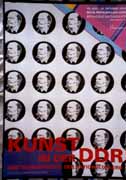 |
| LENIN
LENIN LENIN!--Poster for Art in the DDR exhibition at Berlin's New National
Gallery. Photo: ©Glenn Loney 2003. |
Kunst in der DDR/
Art in the German Democratic Republic—
Neue National Galerie, Berlin
[Closing October 26, 2003]
Even after the death of Josef Stalin, the Soviet Union and Eastern European nations of the Warsaw Pact continued to churn out artworks restricted by the straight-jacket of Soviet Realism. This was certainly very much the case in East Germany, known there as the DDR, or in the West as the GDR: the German Democratic Republic. German it was, but neither a republic nor democratic.
As soon as the Berlin Wall fell in November of 1989, much of the DDR's art output soon vanished from sight, along with the ubiquitous red banners which announced new Five-Year-Plan goals in bold yellow letters. When Goethe's Weimar was Europe's Culture City for a year, however, a major exhibition of DDR Socialist Art was mounted in the citiy's great central culture hall. The propaganda messages of most canvases and sculptures were either muted but clear, or almost visually strident. The show was ultimately depressing, especially as some real talent was apparent, forced into service to the Socialist State. Showing the remains of Hitler's Private Art-Collection at the same time in the same venue certainly did not raise the spirits of viewers. And the show did not answer the unspoken question: were there no dissident painters, sculptors, or designers at all in the DDR?
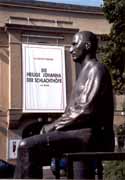 |
| BERT
BRECHT'S STILL IN BERLIN--Socialist Playwright-Poet enjoys his place in
the sun outside his historic Berliner Ensemble theatre. Photo: ©Glenn Loney 2003. |
This summer in Berlin, some of these artworks appeared again, but this time in a different context, for the dissidents were out in force, even though they could not have shown their work in the Communist Era. And wall-texts as well as specific artworks noted trends—both above-ground and underground—during the long night of Socialism. Expressionism, Constructivism, Abstraction, Fantastic Realism, quasi-Cubism: all found their artist-advocates, even if they were not widely shown or seen. Some ingenious artists offered social critiques, but concealed them in symbols or classical references until the dawn of 1990. Via Lewandowsksy's Ikarus, for example, does not exactly celebrate the Successes of Socialism. His flight is cancelled!
At the entrance to this show is a large complicated historio-symbolic and almost savage Boschian canvas by Werner Tübke, titled Christmas Night 1524. As a painter, Tübke is currently out of fashion, for he was a favorite of DDR culture officials. In fact, he was commissioned to paint an immense German Historical Panorama in a great cylinder on a mountain near the much higher peak inwhich Barbarossa is believed to be sleeping until the German People need him. They certainly needed him when half the nation was under the iron heel of the Soviets, but what they got was Tübke's Panorama instead.
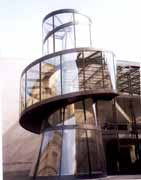 |
| PEI'S
SPIRAL GLASS TOWER--Architect I. M. Pei's Post-Modernist entrance to the
new Exhibition Hall of the German Historical Museum in Berlin. Photo: ©Glenn Loney 2003. |
New I. M. Pei Exhibition Hall—
German Historical Museum, Berlin
[Opened May 25, 2003]
The noble neo-classical mass of the German Historical Museum, on Unter den Linden, was once the Zeughaus, or Prussian State Armory. In the DDR era, it was a museum of Socialist Propaganda. Today, it houses a wide-range of artworks and historical artifacts and documents central to Prussian and more recent German history. In fact, there are so many important archival materials and works of art which need to be on display that space for special exhibitions has been limited.
This changed earlier this year when the new and stunningly Post-Modernist I. M. Pei Austellungshalle wing was added to the old Museum, linked by a passage between the two blocks of buildings. Pei was the innovative architect who gave the Louvre Museum its glass pyramids in his impressive make-over. His signature-symbol for the Historical Museum addition is a towering metal-and-glass spiral cylinder. Although this includes a spiral stair from ground-floor to the second-level, its smaller glass tower is merely decorative. There are, of course, other stairs and elevators which can take viewers to exhibitions on the upper floors.
The effect of the open four-story atrium and the various lobby-levels is breathtaking, but it's a bit like the Frank Lloyd Wright Rotunda of the Guggenheim:
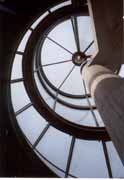 |
| ECHOES
OF THE GUGGENHEIM ROTUNDA--The architecture of I. M. Pei is on display—both
in models and reality—in Berlin. Photo: ©Glenn Loney 2003. |
a vast space in which few paintings can be effectively displayed. Nor is there any room for art inside the glass spiral. Thus, almost half of this impressive new structure is more like an architectural sculpture than a museum. The exhibition spaces, in fact, are even a bit cramped.
Initial Exhibitions:
On the top floor of the new exhibition-hall is an attractive but not wide-ranging
show of some major and recent projects of Pei, with models, photos, and plans.
Was this museum-exposure part of his architect's fee?
Architectural Projects of I. M. Pei/
John F. Kennedy/
The Idea of Europe: Concepts for Eternal Peace
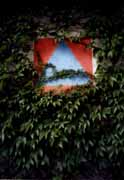 |
| WORLD
WAR II BERLIN SYMBOL--This vine-overgrown triangle marks the great underground
system of air-raid bunkers in the Gesundbrünnen district. Volunteers conduct tours on Saturdays, showing the network of chambers now outfitted with displays of wartime artifacts. Photo: ©Glenn Loney 2003. |
Although the John F. Kennedy show oozed elements of hagiography, it did celebrate his significance in 1963, for the citizens of West Berlin, suddenly cut off from West Germany and even from family andfriends in East Berlin by the Berlin Wall. His famous words at the Wall are still remembered: "Ich bin ein Berliner!" The fact that a Berliner is actually a jelly-doughnut—as well as a citizen of Berlin—was not lost on local wits. One said it was a good thing he had not gone to Hamburg and Frankfurt, which would have made Kennedy both a Hamburger and a Frankfurter!
Far more interesting—but suffering from the confined, convoluted spaces of the lower-level gallery—was The Idea of Europe. This challenging show reviewed earlier historical ideas and efforts to unify the continent, rather than splinter it into competing national interests. Napoleon naturally received his due, and then some. With increasing worries about the direction of the new European Union—in times of severe economic reversals and the threat of immigration-surges from new members in Eastern Europe—thehopes and failures of the Past provided timely food for thought in this show.
Frank Ghery's AXIA at the Brandenburg Gate
Not a museum but a stunning new conference-center is Axia. This astonishing Frank Ghery architecture seems a fairly conventional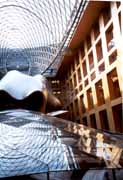 |
| SCULPURE
OR STRUCTURE?--Immense Atrium of architect Frank Ghery's new AXIA conference-complex
close to the Brandenburg Gate in Berlin. Photo: ©Glenn Loney 2003. |
Mittenmang at Berlin's Schwules Museum
[Closing February 15, 2004]
For the record, Schwul in German is the equivalent of Gay. This enterprising museum has been in the forefront of promoting tolerance of Alternate Lifestyles and even acceptance. With the tremendous success of Berlin's annual June Love Parade—which now attracts thousands of marchers, revelers, and gawkers—there is now much more general interest in German Gay Life.
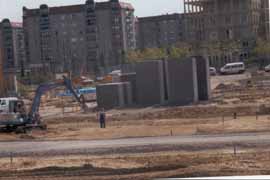 |
| BEGINNING
BERLIN'S HOLOCAUST MEMORIAL--Great stone blocks are set on end between
Potsdam Platz and site of future American Embassy. Photo: ©Glenn Loney 2003. |
The Museum has chronicled the sad history of homosexuals and lesbians in Protestant Prussia, Catholic Bavaria, and the murderous Third Reich. Hitler and his henchmen wanted all "Asocial Elements" removed from society—to Dachau at first, but permanently when possible. A memorable major German Gay History Exhibition was too large for the intimate museum-spaces, so it was held in the prestigious Academy of Art. This helped bring this previously hidden aspect of German life into the mainstream. The catalogue offers an impressive documentation of State and community repressions of homosexuals over the past 200 years. Even after World War II and the defeat of Hitler, West Germany preserved the Nazi's vicious Paragraph 175, which criminalized homosexuality and made it subject to dire punishments.
This current exhibition documents—with photos, letters, and memories—the difficulties and the occasional bright spots of personal lives and relationships of gay men and women in Berlin from 1945 to 1969. It is a more sedate contrast to an S&M exhibtion the museum mounted some seasons ago. This show featured a chamber complete with a sexual-sadist's Torture-Table, a sight not well calculated to elicit tolerance from devout Catholics and Protestants.
Traumfabrik Kommunismus:
Visual Culture of the Era of Stalin—
At Schirn Kunsthalle, Frankfurt
[Closing January 4, 2004]
Although there have been art-exhibitions in recent years focusing on the use of art as propaganda in totalitarian European regimes, most have surveyed Hitler's Nazi Germany, Franco's Falangist Spain, and Mussolini's Brownshirt Italy alongside Stalin's Soviet Union. Kunst der Diktatoren was among the best of these. But this new show in Frankfurt is the first in the West to throw the spotlight exclusively on Stalin and Soviet Realism. It is drawn from many hitherto unseen artworks and documents from the Tretyakov Gallery, Moscow's State Historical Museum, the Russian State Library, and the State Museum of the Armed Forces.
Among the artists—some of them already well-known in the West—are Kasimir Malevich, Gustav Klutsis, Jekaterina Sernowa, and Alexander Deineka. As a valuable counterpoise to the Stalinist propaganda—some of it blatant, some subtle—canvases by Soviet artists who then and now challenge the Socialist Realist Aesthetic are also on view. Among these men: Boris Mikhailov Ilya Kabakov, Erik Bulatov, and Komar andMelamid—whose skillfully painted pictures mock both the content and the styles of Soviet Art.
The exhibition makes the point that not all the approved art was rigidly Realist. Modern design ideas—with the bold color, geometric forms, photo-collages, and attention-getting graphics of Constructivism—were adapted for posters and publications. This is a very informative—as well as attractive—exhibition which should be seen in North America as well.
MARIA CALLAS:
I Mei Gioielli di Scena—
Palazzo della Gran Guardia, Verona
Because Diva assolutta Maria Callas made her debut at the Arena di Verona on
2 August 1947, it was altogether fitting andproper that this glittering exhibition
of her stage-jewelry should be mounted across the great gardens from the Arena.
This also proved to be a promotion for both Swarovski Crystal and Milan's Atelier
Marangoni, which had fashioned a series of remarkable necklaces, diadems, tiaras,
and crowns for Callas.
On view were Callas' crown from Macbeth and tiaras from Trovatore, Gioconda, Fedora, and I Vespri Siciliani. Impressive necklaces from Lucia, Sonnambula, Anna Bolena. Poliuto, and Il Turco in Italia were also on display. Callas insisted on only Swarovski stones for her stage-jewelry, and only Ennio Marina Marangoni to fashion them into dazzling accessories befitting great roles and a very great lady of the opera-stage. And they had to look good, not only from the orchestra, but also way up in the balcony where many of the diva's most devoted fans were usually seated.
The Venice Biennale:
50th International Exposition of Art—
 |
| BLACK
BIRDS OVER EGYPT--Section of external sculptural-installation on Egyptian
Pavilion of the Venice Biennale. Photo: ©Glenn Loney 2003. |
Dreams andConflicts/
Dictatorship of the Viewer—
[Closing November 2, 2003]
Most of the entries in the Biennale were on display either in the ancient Arsenal, with its crenelated brick walls, or in the Art Deco-style International Pavilions of the Giardini della Biennale. The Museo Correr, Stazione Santa Lucia, and some palazzi also hosted innovative artworks. And of course Peggy Guggenheim's famed exhibition-venue was crowded with art-loving tourists. Francesco Bonami has been the Super-Curator, with the Super-Titles listed above as his organizing principles: Sogni e Conflitti/La Dittatura dello Spettatore.
The over-all effect was rather like the Biggest Whitney Biennale ever, even though most of the artists exhibiting were certainly not
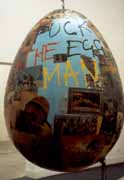 |
| WHO
IS THE EGG MAN?--Collaged photo-images of contemporary Middle-Eastern
turmoil on immense egg-form, a highlight of the Venice Biennale. Photo: ©Glenn Loney 2003. |
Americans. But our trends and styles have a pervasive effect worldwide, in both High Arts and Pop Culture. There were some painful recyclings of ideas and techniques other artists have already exploited to death. But there were also some very impressive and ingenious individual paintings, sculptures, and installations.
The somewhat sprawling Biennale was subdivided into sub-subjects such as Delays and Revolutions, The Zone, Clandestine, Fault Lines, Individual Systems, Zone of Urgency, Utopia Station, The Everyday Altered, Contemporary Arab Representations, andThe Structure of Survival.
The Museo Correr was devoted to painting, from Rauschenberg to Murakami—whose Mr. Pointy-Head recently spent his summer in Rockefeller Center Plaza. Both the Dead and the Living were on display in this effective retrospective of painting over the decades—especially as paintings were unbelievably excluded from some Biennales. Among the Usual Suspects at the Correr:
Anselm Kiefer, Sigmar Polke, Gerhard Richter, Francis Bacon, Erik Bulatov, Francesco Clemente, Bridget Riley, Damien Hirst, Jörg Immendorff, Chuck Close, Philip Guston, Cy Twombly, Julian Schnabel, Ed Ruscha, Roy Lichtenstein, Agnes Martin, and of course Andy Warhol.
 |
| ARTFUL GEOMETRICS--Lines,
angles, planes, and solids produce an elegantly simple sculpture-installation
at the Venice Biennale. Photo: ©Glenn Loney 2003. |
As this entry is only the occasion for reproducing a photo or two I took of artworks on view, I won't attempt to list or describe all the works which impressed, amused, or appalled me. Patricia Piccinini—Australia's pride, with her We Are Family installation—astonished with her humanoid pigs and odd blobs of life. But her Duane Hanson-style human figures were very well observed.
Fred Wilson's varied visions and fantasies dominated the US Pavilion. American racial issues were ingeniously explored. As well as historical racism closer to home in Venice, with baroque Blackamoor figures around the city and onsite. Wilson also provided reverse-running video-loops of Verdi's Otello, from murderous mistrust backward to love.
All in all, this was a colorful, disturbing, and totally amazing show of
international sensibilities—even with that American Edge that creeps in… If
you were not able to get to Venice, do try to find a copy of the catalogue
to see what you missed. It is a stunning publication, one you will want to
keep.
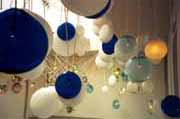 |
| IT'S
ALL IN HOW THEY ARE HUNG--Translucent & transparent glass shapes as
an art-installation at the Venice Biennale. Photo: ©Glenn Loney 2003. |
The immense andvery heavy—but very handsomely photographed and designed—exhibition catalogue cost only Euro 60 on site. I could have had a press-copy, but my suitcases were already leaden with cameras and computer. In the Biennale shop, however, I noticed that examination copies were falling to pieces, as the section-signatures were glued, not stitched. The Rizzoli English catalogue cost $75, but these volumes are sure to turn up down at the Strand Bookshop on Lower Broadway at lower prices.
VIENNA FUTURES:
For Your Next Trip To Vienna
Vienna doesn't have as many museums as New York, but it is always adding
to its roster of interesting galleries and museums. In what was formerly the
Imperial Stables, an entire new arts-complex in the Museum-Quarter has been
developing in recent years. If you have never been to Vienna, you do not want
to miss the massive Kunsthistorisches Museum, crammed with masterpieces collected
by the Hapsburg Emperors. Or the fabled Albertinum, for its Albrecht Dürer original
drawings. But there are many other museum andgallery collections to see, some
especially focused on the development of modern art and design in Vienna.
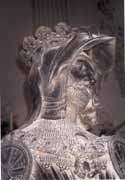 |
| KING
IN ARMOR--Larger-than-life bronze statue standing guard at Hapsburg Tomb
in Austrian Innsbruck. This great monument is flanked by effigies of kings, queens, and emperors of the Hapsburg Dynasty. Photo: ©Glenn Loney 2003. |
Yearning for Beauty:
100 Years of the Wiener Werkstätte—
MAK Exhibition Hall, Vienna
[Closing March 7, 2004]
To salute the Centenary of the Wiener Werkstätte, Vienna's Museum für Angewandte Kunst—or MAK—is mounting a major survey of the remarkably modern designs of such talents as Josef Hoffmann and Koloman Moser, who founded this group of artists and artisans. Even their designs for dishes and silverware, created in 1900, seem totally contemporary. The evolving styles of WW artists range from Art Nouveau, or Jugendstil, to Art Deco and Moderne. Furniture, flatware, ceramics, art-objects, glass, textiles, costumes, designs, posters, interiors, pictures, and architecture are surveyed. MAK has very impressive holdings of vintage Jugendstil art and artifacts, and in Vienna, it can readily draw on important private collections. As for Jugendstil architecture, while the show can only display plans and models, the built-masterpieces of this style of architecture easily can be found both in the heart and the suburbs of Vienna.
Architekturzentrum Wien
[Archives/Library/Changing Exhibitions/Tours] For lovers of the Modern—especially
in architecture, decoration, and design—Vienna is the place to see some of its
earliest manifestations, still in excellent repair and in regular use. Vienna's
Architecture Center is the place to go if you would like to tour some of the
great mansions and public-buildings designed by Otto Wagner, Josef Hoffmann,
and their disciples. Although the center has an excellent research andreference
library, as well as design archives, this is not primarily a museum, with permanent
collections to display.
The library-archives are state-of-the-art Post-Modern. The Az W, as it is known in Vienna, offers special Sunday tours to explore different aspects of Viennese architecture. But it can also organize special tours for groups or tourists, with adequate notice. Twice a year border-crossing tours are conducted to odd corners of Budapest, Bozen, Bratislava, or Brno. Check it out at library@azw.at or on www. azw. at
 |
| COMIX
ON PARADE--Belgian cartoon-characters escort an Old Master painting in
this Brussels Metro mural. Photo: ©Glenn Loney 2003. |
Comix in the Brussels Metro
Asterix is now world-famous, but many other Belgian comic-strip characters have achieved celebrity status, at least in Europe. In the Belgian capital—as in Moscow, Munich, and now even in Manhattan—Metro or subway stations are often decorated with murals, tiles, or artworks which evoke the district they serve. One of these handsome stations has all its wall-space, on both sides of the train-tracks, covered with comic cartoon characters. Some are celebrating distinctively Belgian or Brussels customs and events. But others make satiric mock of civic pretentiousness, as well as the customs andcostumes of comic figures from other lands. Exclamations in Chinese, Italian, or Russian add a note of spurious authenticity to these hilarious scenes. Oddly enough, when you leave this station for the daylight above, you won't find a cityscape remotely comic or cartoonish. It could be somewhere in Queens.
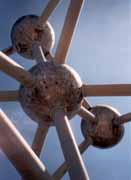 |
| ATOMIUM
STANDS TALL!--Section of this symbol of Brussel's 1957 World's Fair which
is now a major tourist-magnet. Photo: ©Glenn Loney 2003. |
The Great Falkirk Wheel
There is an exhibition and visitor-center at one side of the immense Falkirk Wheel outside Edinburgh, so this may qualify it as a kind of open-air museum-experience. [At least that can justify including a photo of this innovative and impressive feat of engineering in this report.] In addition to its tremendous tourist-appeal, the Falkirk Wheel is central to the program of rejuvenating Scotland's canal-system, too long neglected.
The difference in water-levels between the high waterway of the Union Canal and the much lower Forth andClyde Canal is some 40 meters. Raising or lowering canal-boats with a system of locks today would be incredibly expensive and time-consuming. But the Falkirk Wheel can do this in a matter of minutes. There is still one lower lock to raise boats from the low canal to the level of thegreat wheel's pond. From there, it is 35 meters by gondola to the high waters.
 |
| THE GREAT
FALKIRK WHEEL--Immense arm—with rotating water-filled gondolas—links
high and low Scotttish canals. Photo: ©Glenn Loney 2003. |
The so-called Wheel is essentially a rotating arm, with gondolas filled with water at each end. Once boats are in the low and high gondolas, sensors regulate the water to ensure that the weights are the same. Filled, the combined gondolas can weigh as much as 100 African elephants—600 tons. A series of five giant cogs rotate the Wheel, using 7 kw, the same power as for 8 toasters!
Before the advent of major nation-crossing motorways in the 1960s, these two canals linked Scotland's Atlantic coast with the North Sea. The canals fell into disuse, replaced by heavy freight-trucks.
In the former East Germany, at Niederfinow, there is an even more impressive high-low canal-link. But this is actually an immense Boat-Elevator, in which several boats and barges can be raised at the same time, as in a huge swimming-pool. They float out of the lower Oder Kanal into this immense steel container, rising up 36 meters in the air. Then they float out into the high Finow Kanal, and go on their way. This engineering marvel was begun in 1927, with the official name of Schiffshebewerk Niederfinow. Both the Scots and the German devices are well worth a visit.
[Loney]
Copyright andCopy—Glenn Loney 2003
Copyright © Glenn Loney 2000. No re-publication or broadcast use without proper credit of authorship. Suggested credit line: "Glenn Loney, Curator's Choice." Reproduction rights please contact: jslaff@nymuseums.com.